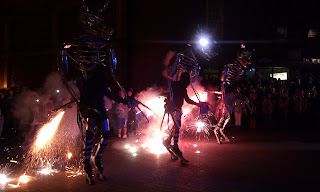In my first "Introduction to Plankton" post I introduced the different types of plankton that live in the ocean. I now would like to expand my introduction and focus on one plankton type at the time. I think the logical way to do it to start from the base of the oceanic food chain upwards (downwards in the picture below in order of appearance in the food web) .
 |
| Oceanic food chain. Phytoplankton at the base , eaten by zooplankton. |
The term "food chain" stands for the representation of what species live in a certain ecosystem (environment) and how they are linked together in a sort of "who eats what" order. Basically all organisms that live in a certain habitat interact with each other, those interaction follow an order which, in simple words, start from the simplest life form upwards.
Different habitats and ecosystems have evolved throughout time different complexities in their food chains, depending on how many species live there and the environmental factors. Although doesn't matter where, they all have one thing in common, the first link of the chain is plants or so called PHYTOPLANKTON (unicellular algae) in the ocean.
Because plants and phytoplankton are the first link in the various chains they are called PRIMARY PRODUCERS. Plants can produce their own food through a process called photosynthesis (this is what autotrophs means: plants are autotrophs). The two most important things that phytoplankton needs to do that are:
So different light intensities and different nutrient concentrations will determine how well phytoplankton grows and develops. Temperature also plays a major role. Different environments often offer different amounts of the 2 required items. For example, think of polar waters compared to equatorial areas, you will find different species of phytoplankton living in these 2 parts of the world. This is because the 2 areas have completely different characteristics, therefore the phytoplankton grows differently and over time evolved to adapt to the specific conditions of the habitats.
Because of this dependence on light, phytoplankton productivity is highest near the surface water and decreases with depth.
The most important Inorganic nutrients necessary for phytoplankton growth are CARBON (C), NITROGEN (N) and PHOSPHATE (P) (macronutrients) plus others so called micronutrients such as IRON (Fe). Micro because they are necessary in smaller quantities for the cells to function.
Generally those nutrients are limited at the surface of the open ocean waters with nitrogen and phosphorus in especially short supply; (this is a primary reason for the relatively low productivity of open oceans). Marine phytoplankton is more productive near the coasts were input of nutrients come from the land running off into the surrounding waters. Also productivity is higher in upwelling areas where nutrient rich waters come to the surface.
In one of the next posts I will talk about the different types of phytoplankton and how to culture it!















